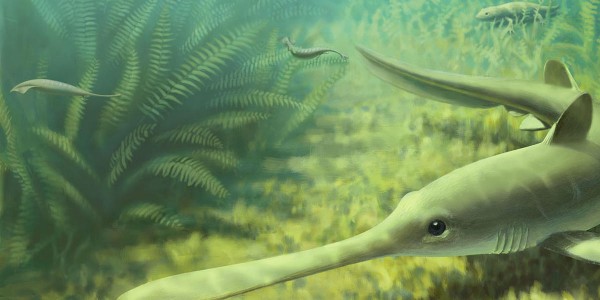By Ana Verayo, | February 22, 2017

An illustration depicts what Mazon Creek--now a rich fossil bed--may have looked like 300 million years ago. ( John Megahan/University of Pennsylvania)
Scientists are trying to re-classify the species of the mysterious Tully Monster. Past studies have classified this ancient creature as a vertebrate. More specifically, as an ancient ancestor of the lamprey, a hideous, jawless fish with a suction type of mouth.
In this new study, a team of paleobiologists has debunked that claim. According to Lauren Sallan of the University of Pennsylvania, this animal is so Bizarre that it does not easily fit into this type of classification. This creature does not have eyes on the side of its head, but rather, cupped on stalks. It also has a pincer on a long proboscis or appendage in the front of its head. However, most of all, the Tully Monster is not a fish.
Like Us on Facebook
The Tully Monster was first discovered during the 1950s in Mazon Creek located in Central Illinois. Scientists have classified it as Tullimonstrum gregarium. Thousands of Tully fossils have been uncovered from ironstone layers dating back to 300 million years old. Since then, scientists have been trying to decipher the mystery of the Tully Monster.
Sallan reveals that it has been initially classified as a worm. Scientists have argued that the creature was some type of mollusk, similar to a sea cucumber. Some say that it is certainly a kind of arthropod, like a lobster.
In a study last year, scientists conducted a re-analysis of around 700 fossils and presented the existence of a backbone and other organs. However, in this new study, scientists suggest that these marine fossils from the Mazon Creek ironstone deposits have preserved soft tissues. In addition, the team claims that lamprey fossil evidence from the same site is not the same as the Tully Monster fossils.
Another telltale feature that the Tully Monster is not a vertebrate isits eyes. Another study claims that the Tully's eyes possess melanosomes or organelles that produce melanin, making them vertebrates. However, researchers of this new study are skeptical about such assumptions. While arthropods and cephalopods have complex eye structures, the Tully Monster does not.
Sallan reveals that the Tully Monster's cupped eyes are simple and without lenses. The argument lies in possessing such complex eyes. If vertebrates have them, then those animals with cup eyes are automatically not vertebrates. However, there are many different animals that have cup eyes like mollusks and some worm species.
Sallan concludes that this misclassification has been very problematic since the Tully Monster is an outlier.
This new study was published in the journal Palaeontology.
-
Use of Coronavirus Pandemic Drones Raises Privacy Concerns: Drones Spread Fear, Local Officials Say

-
Coronavirus Hampers The Delivery Of Lockheed Martin F-35 Stealth Fighters For 2020

-
Instagram Speeds Up Plans to Add Account Memorialization Feature Due to COVID-19 Deaths

-
NASA: Perseverance Plans to Bring 'Mars Rock' to Earth in 2031

-
600 Dead And 3,000 In The Hospital as Iranians Believed Drinking High-Concentrations of Alcohol Can Cure The Coronavirus

-
600 Dead And 3,000 In The Hospital as Iranians Believed Drinking High-Concentrations of Alcohol Can Cure The Coronavirus

-
COVID-19: Doctors, Nurses Use Virtual Reality to Learn New Skills in Treating Coronavirus Patients







